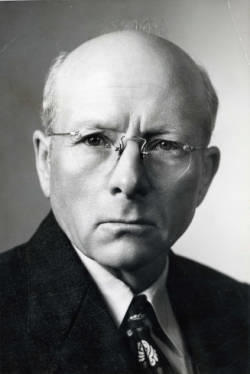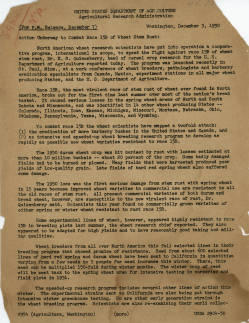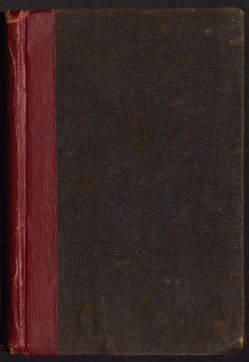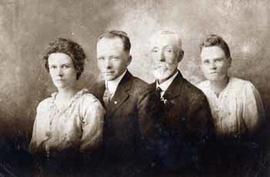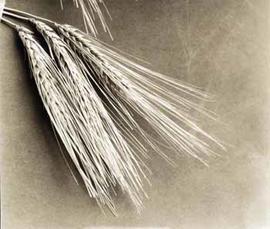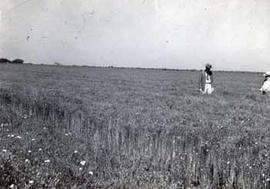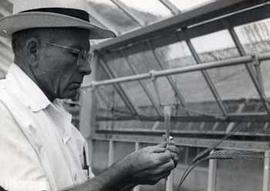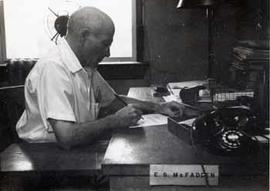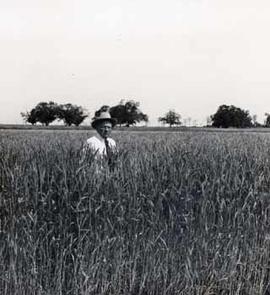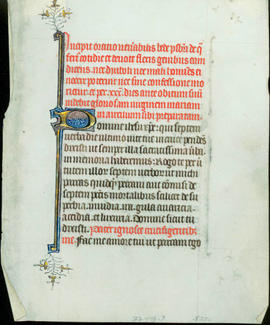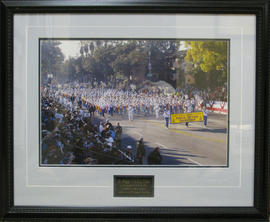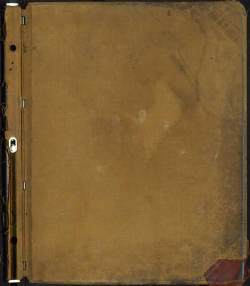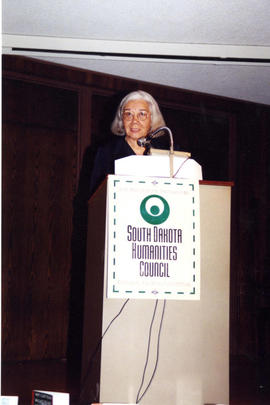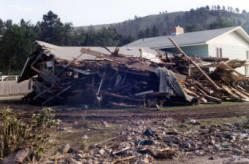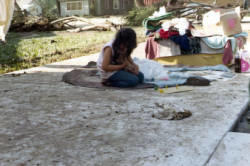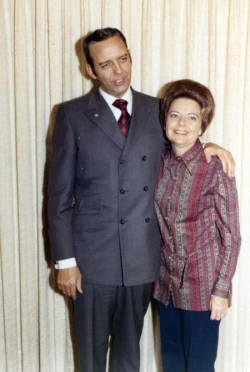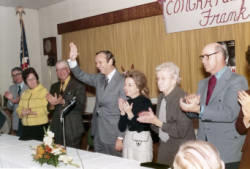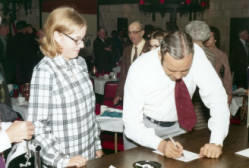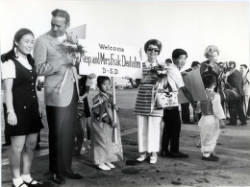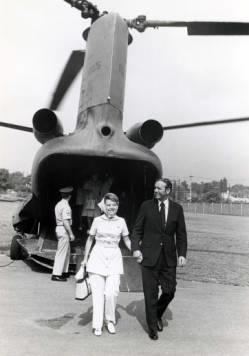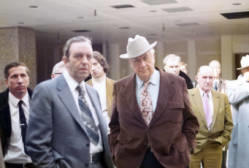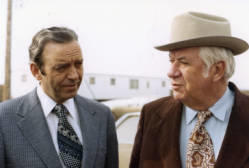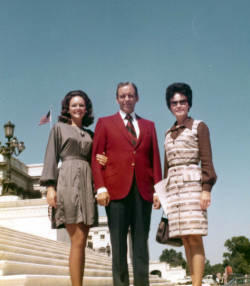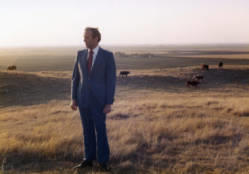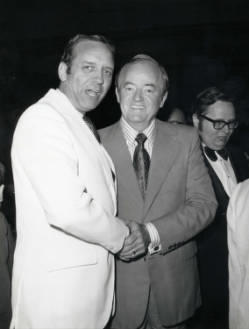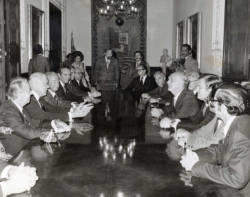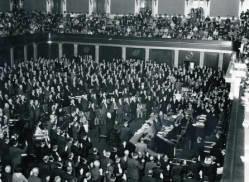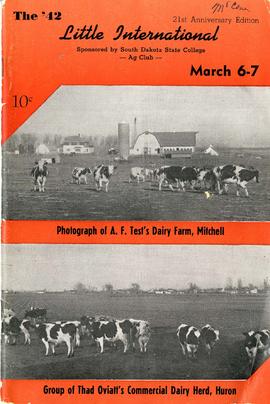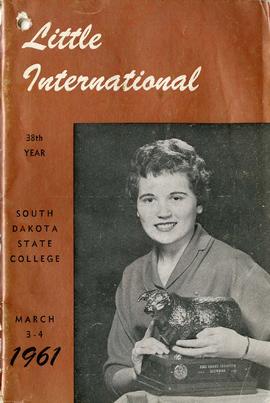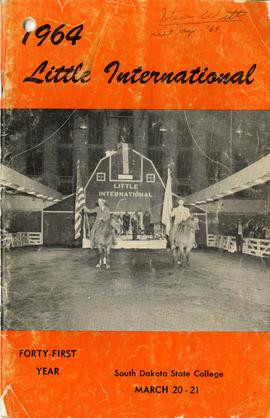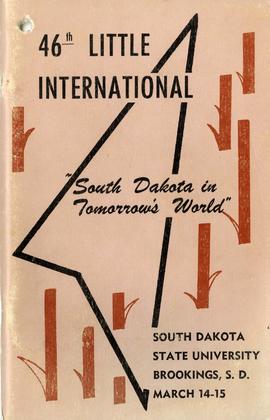The collection consists of materials relating to his work with research and production of small grains such as wheat, oats, and flax, and in particular the development of Hope Wheat. In addition, the collection contains biographical information about McFadden and his writings and speeches.
McFadden, Edgar S. (Edgar Sharp), 1891-1956A handwritten note accompanies the photograph describing Turkey winter and Sheyene flax .
Research notes recorded by Edgar S. McFadden. Research was conducted on barley verities: Success, Hanna, Gold, Minn 105, Odinbrucker, Gatami, Nepal, Hamchen; winter wheat varieties: Turkey, Red Chaff, Kharkov; Rye varieties; and Oats varieties: Ruakura, White Tartarian, Acme, Pelissur, Black Persian. Also included is correspondence between McFadden and J.A. Clark, Assistant Agronomist in charge of Western Wheat Investigation and the U.S. Department of Agriculture, Bureau of Plant Industry.
Research notes recorded by Edgar S. McFadden on cereal breeding for the prairie northwest. Research was conducted on barley varieties: Success, Nepal, Minn 105, Oderbrucker, Gatami, Hanna, Gold, and Hancher; corn varieties: Oea Hirta, Hopi Maiz, Alta, and Ree Flour; winter wheat varieties: Hope, Lutercens, and Buffum. Also included are notes on garden vegetables: spinach, lettuce, onion, dill, beets, carrots, parsnips, beans, cucumber, muskmelon, and watermelon.
Portrait of the McFadden family; from left to right: Mabel Lucille (Blakesly) McFadden, Edgar Sharpe McFadden, James McFadden, Beatrice (Stacking) McFadden
Seven head sections of Success x Gatarni wheat breeding (No. 4); each is labeled with a letter (A through G), the wheat is part of Edgar S. McFadden's research on wheat genetics
Head sections of New Era Barley, the barley is part of Edgar S. McFadden's research
Edgar S. McFadden in a flax field at Kenedy
Edgar S. McFadden doing research in wheat genetics
Edgar S. McFadden at work in his office at Texas A & M University at College Station, Texas
Edgar S. McFadden standing in a field of wheat
Leaf from the Hours of the Virgin. The page is made of velum and was created in France around 1450. The recto contains 18 lines with the first 7 lines have been rubricated. The letter D in the middle of the page has been historiated red, blue, and gold and connected to marginal flourishes. The verso also has 18 lines with several phrases rubricated. The Hours of the Virgin, part of the Book of Hours that include devotional prayers for different times of the day. Hours of the Virgin, also known as the Little Office of the Blessed Virgin Mary, contained psalms, lessons, hymns, and prayers said at each of the eight canonical hours: Matins, Lauds, Prime, Terce, Sext, None, Vespers, and Compline. The Book of Hours was the bestselling book of the Middle Ages.
The collection is composed of manuscripts, correspondence, galley proofs, research, books and publications related to her published works of fiction and nonfiction.
The general material is composed of Norris' juvenilia from Bennington College, instructors' mid-term and final reports of her course work from college, and biographies and interviews of Norris conducted by various media organizations. Also included is a collection of notebooks from the early 1970's to 2009. These notebooks are spiral bound and appear to be daily journals with notes and drafts of poems and essays. They also contain postcards, clippings, business cards, prayer cards, photographs, recipes, etc. Of note is the manuscript for “Elizabeth Kray’s Letters, Memos, and Notes to Marie Bullock: Two Great Ladies of American Poetry”. A 1937 edition of “Conversation at Midnight” by Edna St. Vincent Millay and signed by John H. Norris is also included.
Poetry is composed of Norris' poetry in anthologies, books, catalogs, chapbooks, contributions, and periodicals. These publications all include Norris' poetry, and some also include works by her husband, David Dwyer, (this will be noted on the front of the folder).
Nonfiction books consist of draft and annotated manuscript pages, galley proofs, cover art and typeface layout, book jackets, book notes, correspondence, research, reviews, audio books, international editions, promotional material, book tour information, advance proofs, hard cover and paperback books. Material varies with each book title. This material is arranged alphabetically by publication title.
Other writings consist mainly of essays, reviews, and sermons published in journals, anthologies, books, textbooks, etc. Also included are scripture reflections for daily devotions, Afterword’s, Forewords, Introductions, Prefaces, and Symposia to which Norris has contributed.
Works mentioning Norris are also included. They are composed of publications with articles mention Kathleen Norris.
The book contains 146 plats detailing property boundaries and ownership and leasing of lands on the Pine Ridge Reservation dating between 1936 and 2005. Changes to the plats are recorded on transparency sheets that are placed on top of the original pages. In order to provide as much detail as possible, the digitized copy of the original contains three scanned images for each plat: the transparency sheet and the original sheet, the transparency sheet alone, and the original sheet alone.
The beginning of the book includes a page describing the color code for the shading found within the pages of the book. The shading represents status of the land. Much of this page is faded and difficult to read.
The next page of the book is a typewritten copy of the "Order of Restoration, Pine Ridge Reservation," dated June 10, 1936 and attributed to Harold L. Ickes, United States Secretary of the Interior (1933-1946). The text of the document is as follows:
"Whereas, under authority contained in the Act of Congress approved May 27, 1910 (36 Stat. 440), providing for the classification and disposition of surplus unallotted lands in Bennett County, in the Pine Ridge Reservation, State of South Dakota, certain classes of said surplus lands were opened to settlement and entry under the general provisions of the homestead laws and of the said Act of Congress, by Presidential proclamation of June 29, 1911 (37 Stat. 1691), and Whereas, there are now remaining undisposed of on the opened portion of the Pine Ridge Reservation a number of tracts of said surplus lands which, while of little value for the original purpose of settlement and entry, upon thorough investigation have been found to be valuable to the Indians of the said reservation, and Whereas, by relinquishment and cancellation of homestead entries a small additional area of similar lands may be included within the class of undisposed of surplus lands, and Whereas, the Tribal Council, the Superintendent of the Pine Ridge Reservation, and the Commissioner of Indian Affairs have recommended restoration to tribal ownership of all such undisposed-of lands in the said reservation. Now, therefore, by virtue of the authority vested in the Secretary of the Interior by Sections 3 and 7 of the Act of June 18, 1934 (48 Stat. 984), I hereby find that restoration to tribal ownership of all lands which are now, or may hereafter be, classified as undisposed-of surplus opened lands of the Pine Ridge Reservation, will be in the public interest, and the said lands are hereby restored to tribal ownership for the use and benefit of the Oglala Sioux Tribe of the Pine Ridge Reservation of South Dakota, and are added to and made a part of the existing reservation, subject to any valid existing rights." The Pine Ridge Reservation plats comprise the subsequent pages. The reservation is home to the Oglala Lakota people. It is located in the southwest part of South Dakota in Oglala and Bennett Counties and portions of Jackson County. The boundaries of the Pine Ridge Reservation were established by the United States government through the act of March 2, 1889 (25 Stat. L. 888).
United States. Bureau of Indian AffairsBrief essay on the beginnings of the Oak Lake Writers' Society held at the Oak Lake Field Station in Brookings County, South Dakota.
Elizabeth Cook-Lynn speaking at poetry reading at a South Dakota Humanities Council event.
List of dialogue questions for the participants on the L/D/Nakota Interpretations of the River and Lewis & Clark at the Oak Lake Writers' Society retreat.
Group of writers at the Oak Lake Writers' retreat that includes Charles Woodard and Elizabeth Cook-Lynn (front row).
Schedule for the Twentieth anniversary conference during the Oak Lake Tribal Writers' retreat.
James Abourezk , James Kneip, Frank Denholm, and Richard Kneip at an Agriculture's New Horizon event. They are having a meal at a long table with others.
Frank Denholm shaking hands with two constituents at the Agriculture's New Horizon event.
Frank Denholm talking with constituents by the Democratic headquarters at the South Dakota State Fair in Huron, South Dakota.
Frank Denholm talking with constituents by the Democratic headquarters at the South Dakota State Fair in Huron, South Dakota.
Frank Denholm won first prize in the most handsome category during the Hobo Day in 1955.
Frank Denholm sitting in a chair.
Frank Denholm visiting with constituents in a restaurant.
Frank Denholm with a group of constituents.
Frank Denholm is with a family at an event.
Frank Denholm boarding an airplane. Milie Denholm and the pilot are seated inside the airplane.
Frank Denholm is speaking to constituents in a restaurant.
Frank Denholm is standing at a podium behind a desk. A group of people is standing in the hallway.
Frank Denholm talking to constituents in a restaurant.
Frank Denholm standing on the steps of the U.S. Capitol in Washington, D.C.
Frank Denholm at a luncheon meeting with a group of constituents.
Frank Denholm giving the commencement address to the 1972 graduating class of Sioux Vally High School in Volga, South Dakota.
Frank Denholm speaking at a Memorial Day ceremony in Webster, South Dakota. Veterans and other stand in the distance.
Frank Denholm stands with two constituents on the steps of the U.S. Capitol in Washington, D.C.
Frank Denholm with Mark Small, Jeannie Denholm, James Antonen, and Grant Herfindahl, on the steps of the U.S. Capitol in Washington, D.C.
Flood damage in Rapid City, South Dakota following 15 inches of rain over a small area in the Black Hills caused Rapid Creek and other waterways to overflow on June 9, 1972.
Flood damage in Rapid City, South Dakota following 15 inches of rain over a small area in the Black Hills caused Rapid Creek and other waterways to overflow on June 9, 1972.
Flood damage in Rapid City, South Dakota following 15 inches of rain over a small area in the Black Hills caused Rapid Creek and other waterways to overflow on June 9, 1972.
Flood damage in Rapid City, South Dakota following 15 inches of rain over a small area in the Black Hills caused Rapid Creek and other waterways to overflow on June 9, 1972.
Flood damage in Rapid City, South Dakota following 15 inches of rain over a small area in the Black Hills caused Rapid Creek and other waterways to overflow on June 9, 1972.
Photographer documenting the flood damage in Rapid City, South Dakota following 15 inches of rain over a small area in the Black Hills caused Rapid Creek and other waterways to overflow on June 9, 1972.
Flood damage in Rapid City, South Dakota following 15 inches of rain over a small area in the Black Hills caused Rapid Creek and other waterways to overflow on June 9, 1972.
Workers clearing debris from the flood in Rapid City, South Dakota following 15 inches of rain over a small area in the Black Hills caused Rapid Creek and other waterways to overflow on June 9, 1972.
Young girl holding a puppy and sitting in the driveway of a home damaged by the flood in Rapid City, South Dakota following 15 inches of rain over a small area in the Black Hills caused Rapid Creek and other waterways to overflow on June 9, 1972.
Campaign billboard for Frank Denholm reads Congress Denholm Work
Frank and Millie Denholm
Frank Deenholm standing with his wife, Millie at a podium at a campaign event. There is a banner hanging on the wall which says Congratulations Frank.
Group of people at a Frank Denholm campaign event.
Frank Denholm greeting constituents in a café.
Frank Denholm signing an autograph for an admirer at a campaign event.
Frank and Millie Denholm greeting people at an event.
Frank Denholm speaking to a group of people at an event.
Frank Denholm speaking to a group of people at an event.
Frank Denholm with constituents at an event.
Frank and Millie Denholm and others are in a military transport helicopter during a trip to South Korea.
Frank Denholm and other members of a Congressional delegation in South Korea are on a tour.
Frank and Millie Denholm at an event during their trip to South Korea as part of a Congressional delegation.
Frank Denholm and his wife Millie Denholm are being greeted by students during a trip to South Korea as part of a Congressional delegation.
Frank Denholm and his wife Millie Denholm are being greeted by students during a trip to South Korea as part of a Congressional delegation,
Frank and Millie Denholm walk away from a military transport helecopter on their trip to South Korea as part of a Congressional delegation.
Tip O'Neill and Frank Denholm visit the Lincoln County Rural Water System site with others in South Dakota.
Senator Tip O'Neill and Congressman Frank Denholm visit the Lincoln County Rural Water System site with others in South Dakota
Staff member typing on a typewriter in Frank Denholm's Washington, D.C. office.
Frank Denholm standing with constituents on the steps of the U.S. Capitol in Washington, D.C.
Frank Denholm signing his autograph for a constituent at the South Dakota State Fair in Huron, South Dakota.
Frank Denholm standing with constituents on the steps of the U.S. Capitol in Washington, D.C.
South Dakota Governor Richard Kneip, Congressman Frank Denholm, and others are all holding shovels at a ground breaking ceremony.
Frank Denholm standing in a cow pasture at a western South Dakota ranch.
Congressman Frank Denholm standing in a pasture, there are cows in the background
Frank Denholm standing in front of an abandoned school house. There is a bicycle on the sidewalk in front of the building.
Frank Denholm and George McGovern standing by an airport fence at night. They are both holding luggage.
Frank and Millie Denholm are riding in a convertible in the Hobo Day parade in Brookings, South Dakota.
Frank Denholm riding a horse down a street in a parade.
Frank Denholm shaking hands with a constituent while riding in the South Dakota State University Bummobile during the Hobo Day parade the hobo flag of peace is behind him
Congressman Frank Denholm (left) and Hubert Humphrey (right)
Senator Tip O'Neill is with Congressman Frank Denholm, they are holding a map
Frank Denholm going over a document with another man
Senator George McGovern and Congressman Frank Denholm pose for a photograph with actress Shirley MacLaine
Day County, South Dakota Sheriff Frank Denholm standing by a police car
Frank Denholm, member of the U.S. House of Representatives from South Dakota's 1st district from 1971-1975
Frank Denholm, member of the U.S. House of Representatives from South Dakota's 1st district from 1971-1975
Congressional Delegation to Venezuela
Congressman Frank Denholm is among a U.S. congressional delegation to Venezuela
Members of the United States Congress are taking the oath of office
- 1900 - A.B. Baker University
- 1904 - Baker University
- 1913-1915 - Professor, Head of Education
- 1922 - B.S. University of Wisconsin
- 1926 - M.S. University of Wisconsin
- 1928 - Ph.D. University of Wisconsin
- 1928-1933 - Professor, Head, Education
- 1932-1933 - Director of Summer School
- 1972 - B.S. Indiana University
- 1974 - M.S. Indiana University
- 1982 - Ed.D. Indiana University
- 1998-2002 - Dean of the College of Education and Counseling, Professor, Graduate Faculty
Missing pages 9, 10, 37, 38, 41, 42, 43, 44, 47. 58
South Dakota State University. Little International Agricultural Exposition